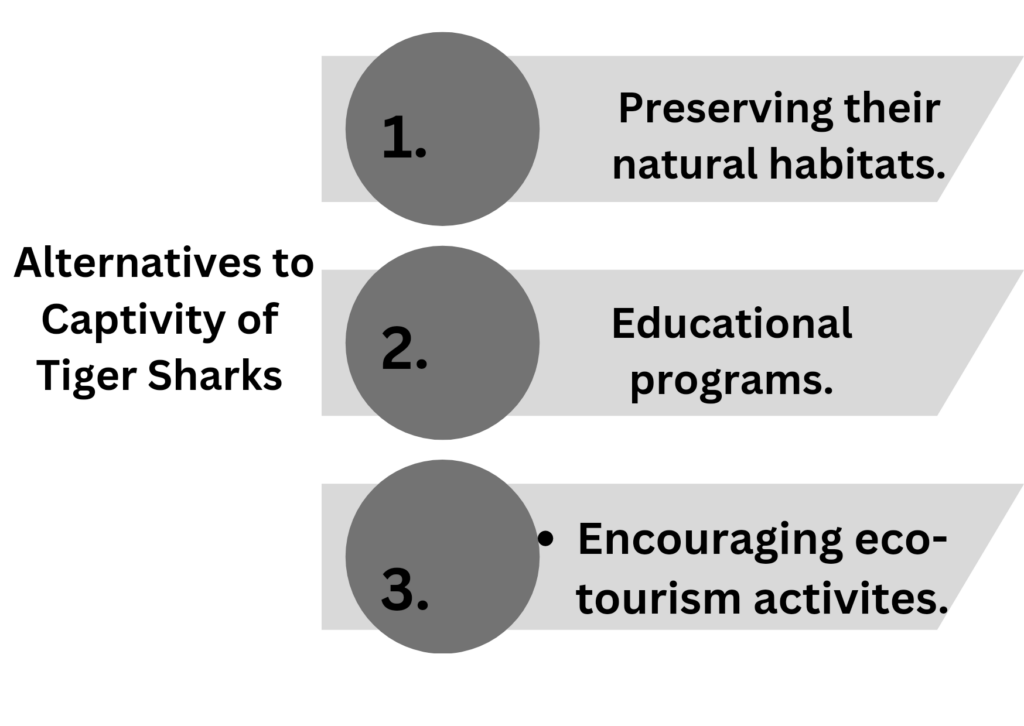
Key Takeaways
- Tiger sharks are large and powerful predators that are not well-suited for captivity. They require vast amounts of space to swim and hunt, which is difficult to replicate in a confined environment.
- Keeping tiger sharks in captivity can lead to various health issues and stress-related problems. These include reduced immune function, abnormal behavior, and even premature death.
- The diet of tiger sharks is another challenge in captivity. These sharks are known to consume a wide range of prey, including fish, seals, and even other sharks. Providing a diverse and appropriate diet in captivity can be extremely challenging.
- Tiger sharks are migratory species that travel long distances in the wild. Captivity restricts their natural behavior and can lead to physical and psychological problems.
- The educational value of keeping tiger sharks in captivity is limited. While some argue that it allows people to learn about these creatures up close, the negative impacts on the sharks’ well-being outweigh any potential educational benefits.
- Conservation efforts should focus on protecting tiger sharks in their natural habitats rather than keeping them in captivity. This includes implementing stricter fishing regulations and creating marine protected areas to ensure their survival in the wild.
- Alternative ways to educate the public about tiger sharks include promoting responsible ecotourism and supporting research initiatives that study these sharks in their natural habitats.
- Overall, the article highlights the importance of considering the welfare and natural behavior of animals when deciding whether to keep them in captivity. In the case of tiger sharks, the negative consequences outweigh any potential benefits, making it crucial to prioritize their conservation in the wild.
The captivating tiger shark – an enigmatic aquatic predator – slithers through the depths with grace. Its sleek silhouette cuts through the water like a finely honed blade. Researchers and enthusiasts alike are fascinated by this formidable creature’s mystique and sheer power. But just what happens when these creatures are held captive?
The impulse to study tigers sharks in captivity is strong. With limited access to them in their natural habitat, studying them in a controlled environment gives us valuable insight into their behavior and physiology. We can explore their feeding patterns and reproductive cycles up close. It also gives us the chance to uncover hidden gems of knowledge that may otherwise go unnoticed.
In a remarkable encounter, a marine biologist discovered a bond between a captive tiger shark named Luna and her caretaker. Despite Luna’s fearsome nature, a companionship formed between her and the researcher. This connection highlighted the immense capacity for understanding and empathy that exists within these majestic creatures.
Captivity brings both excitement and trepidation. We must strive to strike a balance between satisfying our curiosity and ensuring the well-being of these incredible beings. Through research and thoughtful observation, we inch closer to understanding what it means for a tiger shark to be in captivity – and how we can coexist harmoniously with these powerful denizens of the deep.
Background of Tiger Sharks
Tiger sharks have a special look and are fierce hunters. They have dark stripes running down their bodies, which gives them their name. They can grow up to 10-14 feet, making them one of the biggest shark species.
They are known as ‘wastebaskets of the sea‘ because they will eat anything – fish, seals, dolphins, turtles, and even other sharks. Their powerful jaws can crack shells, and their sharp teeth are constantly replacing themselves. This, plus their amazing smell and sight, makes them excellent hunters.
Studies by the University of Hawaii show that their presence helps to keep the balance in the ecosystem. They keep prey populations in check and protect seagrass beds.
Tiger sharks also travel miles and miles in search of food and places to breed. This shows their ability to survive in difficult conditions. Keeping them in captivity is not a wise idea.
Controversy Surrounding Keeping Tiger Sharks in Captivity
To better understand the controversy surrounding keeping tiger sharks in captivity, delve into the ethical concerns and conservation issues. Explore the delicate balance between the well-being of these apex predators and the educational or research value they hold. Consider the implications for their natural habitats and the efforts to protect their dwindling populations.
Ethical Concerns
The ethical issues surrounding holding tiger sharks in captivity are numerous. Capturing such powerful creatures and confining them to a small space is morally questionable. Furthermore, their physical and mental health is drastically affected due to a lack of freedom and proper stimulation. Additionally, taking these predators from the wild depletes wild populations and disrupts marine ecosystems.
A sad example of this comes from 2015, when a video went viral showing a captive tiger shark repeatedly hitting its head against an aquarium tank. This demonstrated how captivity can lead to physical and psychological harm.
Overall, keeping tiger sharks in captivity raises several ethical concerns – it’s like putting a high school bully in a tiny room and expecting him to suddenly become a model citizen.
Conservation Issues
The debate around keeping tiger sharks in captivity has conservation implications. Questions about the ethical treatment of animals and potential damage to wild populations are at the heart of this controversy.
One big conservation worry is the effect on the natural behavior and well-being of tiger sharks in captivity. These apex predators are specifically designed for life in their natural habitats, where they play an important role in sustaining healthy marine ecosystems. In captivity, they may suffer from stress, lack of swimming space, and poor diets, leading to physical and mental issues.
Another issue is that captive tigers may be bred. While this could appear to be a good conservation step to up population numbers, it could cause genetic problems and harm the species in general. It is more important to protect their natural habitats than to rely on breeding programs.
Moreover, keeping tiger sharks in captivity might mislead people about their conservation status. Seeing them confined to tanks or pools could make people ignore the need to preserve their natural habitats and not realize how important it is to protect wild populations.
Fact: In the last 30 years, tiger shark numbers have dropped by over 70% worldwide due to habitat destruction, overfishing, and climate change.
No matter if you’re a fish out of water or a tiger shark in a tank, the argument for and against captivity is sure to create a stir.
Arguments For and Against Captivity
To better understand the topic of “Arguments For and Against Captivity,” let’s explore the section of this article that discusses the benefits and drawbacks of captivity. Discover the benefits of research, education, and conservation that come with captivity, as well as the potential drawbacks related to physical and behavioral health, as well as limited space.
Benefits of Captivity (Research, Education, Conservation)
Captivity can give lots of advantages in research, education, and conservation. These benefits add to knowing about different species and protecting their homes.
- Research: Animals kept in captivity permit scientists to examine their biology, actions, and health closely. Scientists can get data that would be hard to get in the wild. This info helps to make good plans for conserving and knowing complex ecological relationships.
- Education: Zoos and aquariums help people learn about wildlife and environment issues. Showing different species in captivity makes people understand the importance of conserving nature better. Captive facilities also make programs for teaching people about being careful with nature.
- Conservation: Captive breeding programs are vital for saving endangered species. Keeping genetically different populations in controlled environments guards them from being wiped out. This offers hope for their survival for a long time.
- Collaboration: Captivity also offers the opportunity to join forces between institutions. Zoos, research centers, and conservation organizations working together can use resources, expertise, and knowledge to make better conservation strategies that help many species.
It is necessary to be aware that while captivity has these benefits, it is important to think about ethical considerations to make sure animals in captivity are well taken care of. It is important to give proper care and enrichment to avoid bad effects on the animals.
Pro Tip: Support institutions with high standards for animal care, research, education, and conservation. Don’t forget, dolphins need social distancing too!
Drawbacks of Captivity (Physical and Behavioral Health, Limited Space)
Confining animals has its downfalls – health, both physical and behavioral, is detrimentally affected, with limited space being the major issue. How these drawbacks affect captive animals must be observed.
- Physical Health: Confined animals may suffer from various ailments because of no exercise and an unnatural habitat. They have no space to roam, leading to muscle wastage, obesity, and a lowered immune system.
- Behavioral Health: Confined animals often have strange behaviors like pacing back and forth or hurting themselves due to stress and dissatisfaction. This leads to psychological disorders and overall poor wellbeing.
- Limited Space: Animals are restricted to small areas, so they can’t do things like hunt or move freely, leading to boredom and mental distress.
- Social Interaction: Confined animals don’t have relationships with other members of their species. This isolation can result in depression and loneliness, as social relationships are very important for emotional health.
- Poor Nutrition: Confined animals’ diets are usually inadequate and lack variety compared to their wild counterparts. This can cause nutrition deficiencies that impair their health and immune system performance.
- Reduced Reproductive Success: Many confined animals face difficulties with reproduction due to stress, incompatible pairs, or inadequate breeding environments. This is a threat to the long-term survival of captive populations.
It’s clear that taking care of the physical and behavioral health of confined animals is essential for their overall wellbeing. It’s imperative to comprehend the unique needs of different species to provide adequate solutions.
To solve these issues, bigger enclosures with enriching activities like puzzle feeders or sensory items allow animals more room to move around and keeps them mentally stimulated. Additionally, allowing socialization through introducing compatible individuals or species gives them the chance to form bonds. To do this, living spaces need to be designed to encourage positive interactions and engagement.
Also, a nutritionally balanced diet similar to their natural feeding habits must be given. Diet enrichment strengthens physiological health, reduces stress, and improves overall wellbeing. So why limit tigers to just prowling the ocean when they can live their best life as fish in a tank?
Case Studies of Tiger Sharks in Captivity

To gain a comprehensive understanding of the topic, delve into case studies of tiger sharks in captivity. Explore the success stories, challenges, and failures surrounding these magnificent creatures. Gain insights into their captivity experiences and the various outcomes that have been observed.
Success Stories
These Success Stories show how aquariums have bred tiger sharks successfully. They’ve also trained them for research, helping scientists learn more about their biology and behavior.
Visitors have been made aware of the importance of conserving these creatures. Funds have been raised to support research and conservation as well.
Furthermore, these Stories reveal that tiger sharks can adapt to captive environments without suffering. Organizations are also striving to create more naturalistic habitats for the tiger sharks.
The Marine Biological Association of the UK found that tiger sharks have an impressive sense of smell. They can even detect prey from far away!
Their keepers are kept on their toes with failed escape attempts and refusal of vegan food!
Challenges and Failures
Tiger sharks in captivity face many issues. Adapting to a confined space can cause stress. Replicating their natural habitat is hard, plus it’s difficult to provide the right diet. These problems come from the complexities of housing them in an artifical setting.
The little area limits their ability to swim and act naturally. No ocean currents means they don’t get enough exercise. And, their size and predatory nature make finding hiding spots and activities for mental stimulation hard.
Despite all this, zoos and aquariums try their best to create a habitat that’s like home. They use lots of resources and techniques to give the sharks the right space, water, temperature and tank furnishings.
At Monterey Bay Aquarium in California, they’ve had success with one captive breeding program. With careful care and husbandry practices, they’ve been able to breed tiger sharks in captivity, for conservation efforts.
Alternatives to Captivity

Tiger sharks are magnificent creatures that should be admired in their wild habitats. Captivity is not necessary to experience these animals. Here are alternative ways to appreciate them:
- Preserving their natural habitats is a must for their survival. Conservation efforts will keep these stunning creatures in their own environment.
- Educational programs about tiger sharks can increase awareness and appreciation for them and their importance in the ecosystem.
- Encouraging eco-tourism activities, such as shark-watching tours or snorkeling expeditions, allows people to observe tiger sharks in a respectful way. This also generates income for local communities and preserves their habitats.
Researching their behavior, migration patterns, and feeding habits will help make informed decisions regarding their protection.
True Story: In Costa Rica, researchers studied tiger shark populations off the Pacific coast. Through satellite tagging, they found out that these sharks travel great distances and have complex social structures. This research highlighted the importance of protecting their habitats and revealed how much we still have to learn about them.
By prioritizing alternatives to captivity and investing in scientific research, we can appreciate and protect tiger sharks, while ensuring their long-term survival.
Frequently Asked Questions
1. Can tiger sharks be kept in captivity?
Yes, tiger sharks can be kept in captivity, but it requires specialized facilities due to their large size and specific needs.
2. What size of tank is needed to house a tiger shark?
A tank for a tiger shark should be at least 10 times the length of the shark to provide sufficient space for its swimming abilities. A tank around 50 feet long is a good starting point.
3. What do tiger sharks eat in captivity?
In captivity, tiger sharks are typically fed a diet consisting of various fish, squid, and occasionally larger marine mammals to meet their nutritional requirements.
4. How do aquariums ensure the well-being of tiger sharks?
Aquariums with tiger sharks follow strict protocols to maintain their well-being, including regular health checks, monitoring water quality, providing a balanced diet, and enriching their environment to stimulate natural behaviors.
5. Do tiger sharks survive well in captivity?
With proper care and suitable living conditions, tiger sharks can thrive in captivity. However, it is essential to meet their specific needs and provide a spacious, well-maintained environment.
6. Are there any drawbacks to keeping tiger sharks in captivity?
While captive environments aim to replicate natural conditions, some argue that keeping large marine predators like tiger sharks in captivity may limit their ability to roam freely and exhibit natural behaviors.
Conclusion
Tiger sharks are amazing! But, their captivity brings up important concerns. They need large habitats to live, so it’s hard to keep them in aquariums. Plus, their aggressive behavior is risky for humans and other sea life.
We must not forget the effects of captivity on these powerful animals. Studies show they can be stressed and confused with no natural surroundings and restricted movement. This could cause health issues, lower breeding capabilities and even death.
Tiger sharks are key to keeping ocean ecosystems balanced. As apex predators, they regulate other creatures and protect coral reefs and seagrass beds. By keeping them captive, we disturb the balance and harm the oceans.
We must consider the history of keeping tiger sharks in captivity too. Some say it helps conservation, but the cost to these beautiful creatures is too high. There have been cases of neglected tigers in captivity, showing the ethical implications of keeping them for entertainment or education.
References
https://a-z-animals.com/blog/pet-sharks-in-an-aquarium-is-this-a-good-idea/




